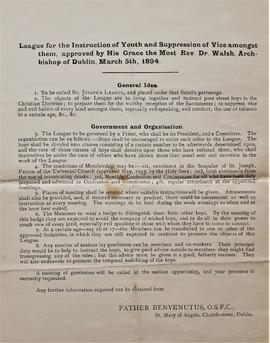Legal documents arising out of efforts to establish title to the properties known as nos. 138-140 Church Street. The properties consisted of three dwelling houses fronting onto Church Street and four houses in Willis’s Court. In 1886, Fr. Nicholas Murphy OSFC and other Capuchin friars agreed to purchase John Coyle’s interest in a lease of the properties dated 28 May 1856 (See CA CS/2/2/3/2). The Capuchins also intimated an interest in purchasing the interest of John Coyle’s landlord, Frederick Kennedy, whose title derived from a lease of the premises for lives renewable forever at the yearly rent of £27 6s 0 (late Irish currency) dated 2 Oct. 1783. It was resolved that Coyle would take a conveyance of the properties from Kennedy (See CA CS/2/2/3/10) and that Coyle would then convey the interests in both leases to the Capuchins. The transfer of the properties was rendered more difficult by the loss of the original lease of 2 Oct. 1783 and by the absence of registered copies of Kennedy’s renewal leases of 28 Dec. 1815 and 13 June 1856 (See CA CS/2/2/3/1). The file includes legal documents generated in order to prove title to the interests held by both Coyle and Kennedy and to facilitate the transfer of the premises to the Capuchin friars. The documents include:
• Copy memorial of a lease (2 Oct. 1783) from George Kiernan, apothecary, and others to Robert Shutter, merchant, of the above-noted properties for lives renewable forever at the yearly rent of £27 6s 0. Copy made at the Registry of Deeds, 10 Mar. 1883.
• Assignment from John Hanrick and Joseph Bolger of the aforementioned premises to John Coyle in consideration of the sum £220. 2 Apr. 1883. With copies of said assignment.
• Abstract of title of Maryanne O'Brien and the trustees of the will of the late James Willis to houses and premises at 138-140 Church Street with four houses at the rear of 139 Church Street in Willis's Court. 20 Apr. 1883.
• Copy will and probate of John Willis, 139 Church Street, Dublin, 4 Feb. 1865. Willis died on 24 Feb. 1865. The copy will was compiled by Frederick Kennedy, 4 Lower Ormond Quay, c.1886.
• Instructions for Philip White, barrister, to advise on title occasioned by the transfer of nos. 138-140 by John Coyle to Fr. Nicholas Murphy and other Capuchin friars. The instructions refer to the intention of the Capuchin friars to demolish the four houses in Willis’s Court and to sell or demise the three houses fronting onto Church Street for a period of twenty years. White wrote: ‘On the whole I would, having regard to the fact that no other premises will suit the querists’ [the Capuchins] purpose, and to the fact that querists have had the risk of being restrained from pulling down the houses thoroughly explained to them and that they are prepared to run the risk, accept the title shown both to Coyle’s and Kennedy’s interests’. 23 Nov. 1886.
• Abstract of title of Frederick Kennedy to premises on Church Street. The abstract commences with a recital of the lease of George Kiernan and others to Robert Joseph Shutter of a ‘messuage, tenement and dwelling house … situate on the west side of Church Street ... containing in the front to the said street from north to south 55 feet, in the rear 22 feet, and in depth from east to west 185 feet … situate in the parish of St. Michan, for lives renewable forever at the yearly rent of £27 6s 0d. The abstract concludes with reference to an assignment of said premises by Henry Smith to Frederick Kennedy (12 Mar. 1883). The document was prepared by Frederick Kennedy in c.Nov. 1886.
• Conveyance and assignment by John Coyle to Fr. Nicholas Murphy OSFC and others of the aforementioned properties. In consideration of £710. 14 Jan. 1887.
• Conveyance by Fr. Nicholas Murphy OSFC and others to Fr. Paul Neary OSFC and others of the aforementioned properties on Church Street to hold in fee simple. (17 Mar. 1888).

